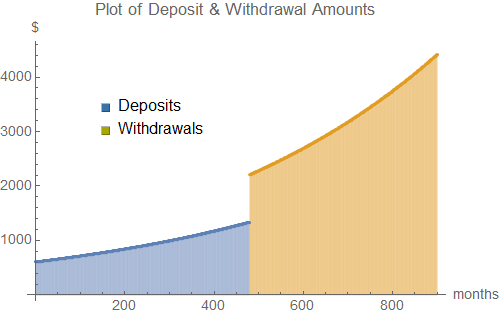Copying a simple example from here, showing 4 deposits and 3 withdrawals.
Planning to retire in 4 months and draw monthly income of £1000 (present value) for 3 months, adjusted for inflation. APR is 8% and inflation is 4%. What should the pot be?

Calculating the monthly rates, assuming effective annual rates.
inf = 0.04;
i = (1 + inf)^(1/12) - 1 = 0.00327374
apr = 0.08;
m = (1 + apr)^(1/12) - 1 = 0.00643403
To illustrate the calculation, say we know at month 3 immediately after the final deposit, the pension pot p should be £3010.57
In month 4 it will have grown by (1 + m) and the inflation adjusted withdrawal will be w (1 + i)^4, where w = £1000. So the pension will decrease like so
p = 3010.57
p = p (1 + m) - w (1 + i)^4 = 2016.78
p = p (1 + m) - w (1 + i)^5 = 1013.28
p = p (1 + m) - w (1 + i)^6 = 0
This can be calculated in one go using a formula
o = 4 . . the month number
n = 3 . . the number of months
p = 3010.57
((1 + i)^o (-(1 + i)^n + (1 + m)^n) w)/(i - m) + (1 + m)^n p = 0
and more usefully, it can be expressed as a formula for p
p = ((1 + i)^o (1 + m)^-n ((1 + i)^n - (1 + m)^n) w)/(i - m) = 3010.57
So we need £3010.57 in month 3 for inflation adjusted withdrawals of £1000.
Starting with deposit d and increasing it to compensate for inflation
p = d
p = p (1 + m) + d (1 + i)^1 = 2.00971 d
p = p (1 + m) + d (1 + i)^2 = 3.0292 d
p = p (1 + m) + d (1 + i)^3 = 4.05854 d
This can also be calculated with a formula
q = 3 . . the final month number
p = (d ((1 + i)^(1 + q) - (1 + m)^(1 + q)))/(i - m) = 4.05854 d
We know p = 3010.57
∴ d = 3010.57/4.05854 = 741.79
The above can be expressed as a formula for d
d = ((i - m) p)/((1 + i)^(1 + q) - (1 + m)^(1 + q)) = 741.79
So the first deposit will be £741.79
The next month the deposit will be £741.79 (1 + i) = £744.21 etc.
The first withdrawal will be £1000 (1 + i)^4 = £1013.16 etc.
Putting the steps together
inf = 0.04;
i = (1 + inf)^(1/12) - 1 = 0.00327374
apr = 0.08;
m = (1 + apr)^(1/12) - 1 = 0.00643403
o = 4 . . the first withdrawal month number
n = 3 . . the number of withdrawal months
w = 1000 . the present value of the withdrawal amount
p = ((1 + i)^o (1 + m)^-n ((1 + i)^n - (1 + m)^n) w)/(i - m) = 3010.57
q = 3 . . the final deposit month number
d = ((i - m) p)/((1 + i)^(1 + q) - (1 + m)^(1 + q)) = 741.79
These same formulas can be used on a more realistically scaled calculation.
A more realistic calculation
For example, suppose someone at age 25 wants to withdraw $1000 per month present value from age 65 to 100. Inflation is 2% pa and interest is 3% pa (effective rates).
(65 - 12) * 12 = 480 deposit months
(100 - 25) * 12 = 900 months overall
inf = 0.02;
i = (1 + inf)^(1/12) - 1 = 0.00165158
apr = 0.03;
m = (1 + apr)^(1/12) - 1 = 0.00246627
o = 480
n = 420
w = 1000
p = ((1 + i)^o (1 + m)^-n ((1 + i)^n - (1 + m)^n) w)/(i - m) = 784011.41
q = 479
d = ((i - m) p)/((1 + i)^(1 + q) - (1 + m)^(1 + q)) = 606.00
They could achieve this by making 480 deposits, starting at $606 and increasing monthly in line with inflation: $607, $608, $609 etc.
The first withdrawal at age 65 will be $2208.04: $1000 present value, i.e. w (1 + i)^480.


